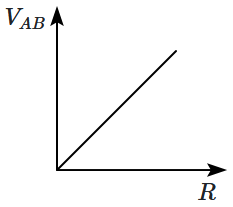Select Question Set:
Given below are two statements:
Assertion (A):
In the Wheatstone Bridge shown in the figure, if the resistances in opposite arms are switched (i.e. \(Q, R\) are exchanged) then the bridge remains balanced if it was initially balanced.
Reason (R):
The balance condition \(\dfrac P Q\) = \(\dfrac R S\) is not affected if resistances in opposite arms are switched.

1.
(A) is True but (R) is False.
2.
(A) is False but (R) is True.
3.
Both (A) and (R) are True and (R) is the correct explanation of (A).
4.
Both (A) and (R) are True but (R) is not the correct explanation of (A).
Subtopic: Wheatstone Bridge |
82%
From NCERT
To view explanation, please take trial in the course.
NEET 2026 - Target Batch - Vital
Hints
To view explanation, please take trial in the course.
NEET 2026 - Target Batch - Vital
For what value of \(R\) will the power supplied by the battery (EMF = \(8~\text{V}\), internal resistance = \(5~\Omega\)) to the resistance \(R\) will be a maximum?

1. \(5~\Omega\)
2. \(4~\Omega\)
3. \(2~\Omega\)
4. \(8~\Omega\)

1. \(5~\Omega\)
2. \(4~\Omega\)
3. \(2~\Omega\)
4. \(8~\Omega\)
Subtopic: Heating Effects of Current |
From NCERT
To view explanation, please take trial in the course.
NEET 2026 - Target Batch - Vital
Hints
To view explanation, please take trial in the course.
NEET 2026 - Target Batch - Vital
The two switches \(S_1,S_2\) are switched on simultaneously. The current through the cell \(E_{1}\) is, initially,


| 1. | \(\dfrac{E_{1}}{R}\) | 2. | \(\dfrac{E_{2}}{R}\) |
| 3. | \(\dfrac{E_1 - E_2}{R}\) | 4. | \(\dfrac{E_1 - E_2}{2R}\) |
Subtopic: Kirchoff's Voltage Law |
70%
From NCERT
To view explanation, please take trial in the course.
NEET 2026 - Target Batch - Vital
Hints
To view explanation, please take trial in the course.
NEET 2026 - Target Batch - Vital
The current passing through a certain device doubles when the temperature rises by \(10^{\circ}\text{C}\), in the temperature range from \(0^{\circ}\text{C}\) to \(500^{\circ}\text{C}\). This effect is used to measure the temperature of a sample. The current is measured to be \(5~\text{mA}\) at \(15^{\circ}\text{C}\) and then the next measurement shows a current of \(50~\text{mA}\). The temperature of the new measurement is nearly: (take \(\text{log}_{10}2 \simeq 0.3\), if required)
1. \(150^{\circ}\text{C}\)
2. \(50^{\circ}\text{C}\)
3. \(450^{\circ}\text{C}\)
4. \(25^{\circ}\text{C}\)
1. \(150^{\circ}\text{C}\)
2. \(50^{\circ}\text{C}\)
3. \(450^{\circ}\text{C}\)
4. \(25^{\circ}\text{C}\)
Subtopic: Derivation of Ohm's Law |
65%
From NCERT
To view explanation, please take trial in the course.
NEET 2026 - Target Batch - Vital
Hints
To view explanation, please take trial in the course.
NEET 2026 - Target Batch - Vital
All the resistances in circuit are \(2~\Omega\) each, \(E_1=4~\text{V}\) and \(E_2=1~\text{V}\). The potential difference between \(C\) and \(D\) (i.e. \(V_{C}-V_{D}\)) is:


| 1. | \(1.5~\text{V}\) | 2. | \(-1.5~\text{V}\) |
| 3. | \(1.2~\text{V}\) | 4. | \(-1.2~\text{V}\) |
Subtopic: Kirchoff's Voltage Law |
58%
From NCERT
To view explanation, please take trial in the course.
NEET 2026 - Target Batch - Vital
Hints
To view explanation, please take trial in the course.
NEET 2026 - Target Batch - Vital
A cell is connected between \(A\) and \(B\) and it is observed that \(V_{C}=V_{D}\) while the corresponding ammeter current is also noted. When the cell (between \(A\) and \(B\)) is disconnected, and ends \(B\) and \(C\) are connected: the current through an ammeter \(A\) is found to have the same magnitude (but in opposite direction). Then, the resistance \(R\) is:


| 1. | equals \(400~\Omega.\) |
| 2. | equals \(200~\Omega.\) |
| 3. | can have any value less than \(400~\Omega.\) |
| 4. | cannot be determined from the given information. |
Subtopic: Kirchoff's Voltage Law |
From NCERT
To view explanation, please take trial in the course.
NEET 2026 - Target Batch - Vital
Hints
To view explanation, please take trial in the course.
NEET 2026 - Target Batch - Vital
All the cells, shown in the figure below, are of \(2~\text V,\) and all the resistances are \(1~\Omega.\) When a potential difference \(V\) is applied between \(A\) and \(B,\) the current through the circuit doubles compared to the situation when the potential difference is made zero. Then;


| 1. | \(V=2\) volts, positive at \(A.\) |
| 2. | \(V=2\) volts, negative at \(A.\) |
| 3. | \(V=6\) volts, positive at \(A.\) |
| 4. | \(V=6\) volts, negative at \(A.\) |
Subtopic: Kirchoff's Voltage Law |
From NCERT
To view explanation, please take trial in the course.
NEET 2026 - Target Batch - Vital
Hints
To view explanation, please take trial in the course.
NEET 2026 - Target Batch - Vital
All the resistances in the circuit shown below are \(2~\Omega.\) The equivalent resistance between \(A\) and \(C\) is:


| 1. | \(4~\Omega\) | 2. | \(2~\Omega\) |
| 3. | \(\dfrac43~\Omega\) | 4. | \(\dfrac{10}3~\Omega\) |
Subtopic: Combination of Resistors |
73%
From NCERT
To view explanation, please take trial in the course.
NEET 2026 - Target Batch - Vital
Hints
To view explanation, please take trial in the course.
NEET 2026 - Target Batch - Vital
The potential difference \(V_{AB}\) (in volts) is plotted as a function of the resistance \(R.\) The graph is given by:


| 1. |  |
2. |  |
| 3. |  |
4. |  |
Subtopic: Derivation of Ohm's Law |
52%
From NCERT
To view explanation, please take trial in the course.
NEET 2026 - Target Batch - Vital
Hints
To view explanation, please take trial in the course.
NEET 2026 - Target Batch - Vital
The current flowing through the left \(20~\Omega\) resistor is:


| 1. | \(1~\text A\) | 2. | \(0.5~\text A\) |
| 3. | \(2.5~\text A\) | 4. | \(3~\text A\) |
Subtopic: Kirchoff's Voltage Law |
58%
From NCERT
To view explanation, please take trial in the course.
NEET 2026 - Target Batch - Vital
Hints
To view explanation, please take trial in the course.
NEET 2026 - Target Batch - Vital
Select Question Set:






